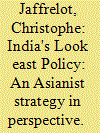|
|
|
Sort Order |
|
|
|
Items / Page
|
|
|
|
|
|
|
| Srl | Item |
| 1 |
ID:
055675


|
|
|
|
|
| Publication |
2003.
|
| Summary/Abstract |
How did Indian democracy avoid the fate of other Third World democracies that collapsed in the face of distributional conflicts, when such conflicts were in ample evidence in India? The traditional answer is that the inclusiveness of the Indian National Congress during the independence movement gave the party legitimacy after independence and allowed it to contain social conflict. This argument fails to account for the persistence of Indian democracy after the 1960s. This article suggests that the pre-independence Congress did not accommodate challengers from below as is commonly suggested, but rather outflanked them by championing still weaker groups further down the social ladder. This "sandwich tactic" has been used repeatedly by Congress leaders during successive crises and accounts for the party's long innings in power, its continued strength today, and, inter alia, the acquiescence of Indian elites in electoral democracy.
|
|
|
|
|
|
|
|
|
|
|
|
|
|
|
|
| 2 |
ID:
055677


|
|
|
|
|
| Publication |
2003.
|
| Summary/Abstract |
In the wake of the terrorist attacks of September 11, 2001, public debate flourished in the United States regarding the dearth of experts with foreign language skills in "critical areas" working in fields such as diplomacy, national security, and law enforcement. One result of this debate was a major increase in federal funding for language and area studies programs, specifically those focused on South and Central Asia, the Middle East, and Russia/the former Soviet Union. Yet increasing funding in this way assumes that the expertise problem is one of quantity. With respect to the South Asian region, the author suggests that unless concerted attention is focused on the reasons these programs are not producing experts engaged with the policy world in the first place, increasing funding will not increase expertise in Washington. This essay argues that the problem is not one of quantity, but rather one of quality - specifically, the lack of existing networks to utilize South Asia experts - and offers some solutions to bridge the gap
|
|
|
|
|
|
|
|
|
|
|
|
|
|
|
|
| 3 |
ID:
055678


|
|
|
|
|
| Publication |
2003.
|
| Summary/Abstract |
Academic discourse on ethnic conflict in India has, all too often, amounted to little more than platitudes, hand-wringing, and blame-casting. Far too seldom do we see an investigation of the topic that is firmly grounded in both theory and on-the-ground data collection: a soberly argued, articulately presented work examining the local circumstances that make Hindu-Muslim conflict more or less likely to flare into bloodshed. Even apart from the added timeliness produced by last year's conflagration in Gujarat, Ashutosh Varshney's new book, Ethnic Conflict & Hindus & Muslims in India, is a welcome contribution to a field sorely in need of such creative, clear-headed, and academically rigorous thinking. It provides the opportunity, moreover, to review the existing schools of thought attempting to explain ethnic conflict, and highlight their inadequacies as a comprehensive framework for analysis.
|
|
|
|
|
|
|
|
|
|
|
|
|
|
|
|
| 4 |
ID:
055676


|
|
|
|
|
| Publication |
2003.
|
| Summary/Abstract |
Indian nationalist leaders developed a strong interest in Asia right from the early nineteenth century. Jawarharlal Nehru articulated an Asianist ideology based on the cultural affinities between India and China and the geopolitical interest in Greater India. This approach, which culminated in the Bandung summit, was put into parenthesis after the 1962 war. The Cold War, during which India and South East Asia were in different camps, prompted differing paths towards in emulating the economic progress of Japan, Taiwan and South Korea, and different approaches towards the development of the ASEAN. India's Asianist policy met an uneven fate but, by and large, there has been a significant rapprochement between India and East Asia. This move materialized in the investments of several Asian countries - including South Korea - in India and the entry of India in the ARF. Yet, the symbiosis between India and Southeast Asia remains hindered by the rather nationalistic view of the latter region that the Hindutva movement is still propagating: like in the colonial period, Asianism remains part of an instrumentalist strategy.
|
|
|
|
|
|
|
|
|
|
|
|
|
|
|
|
|
|
|
|
|